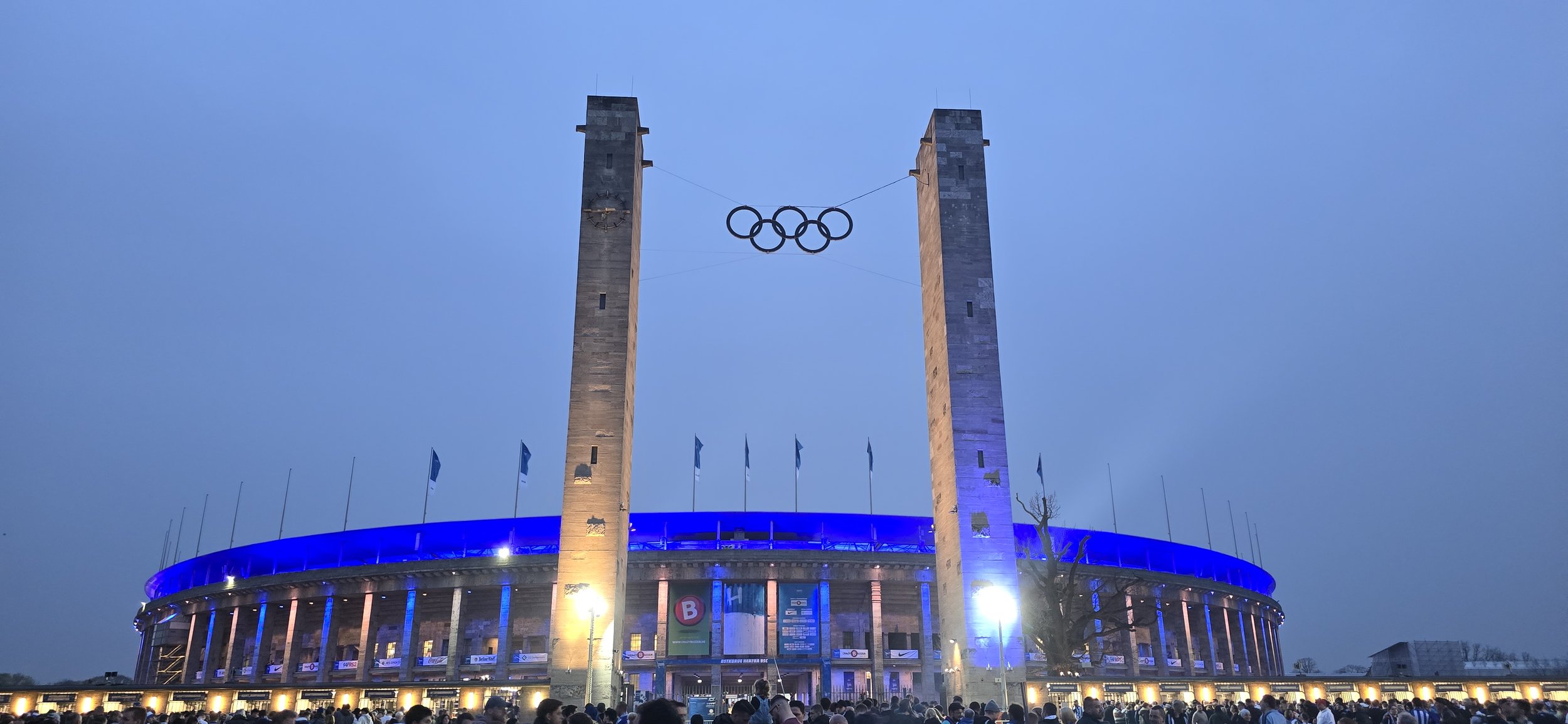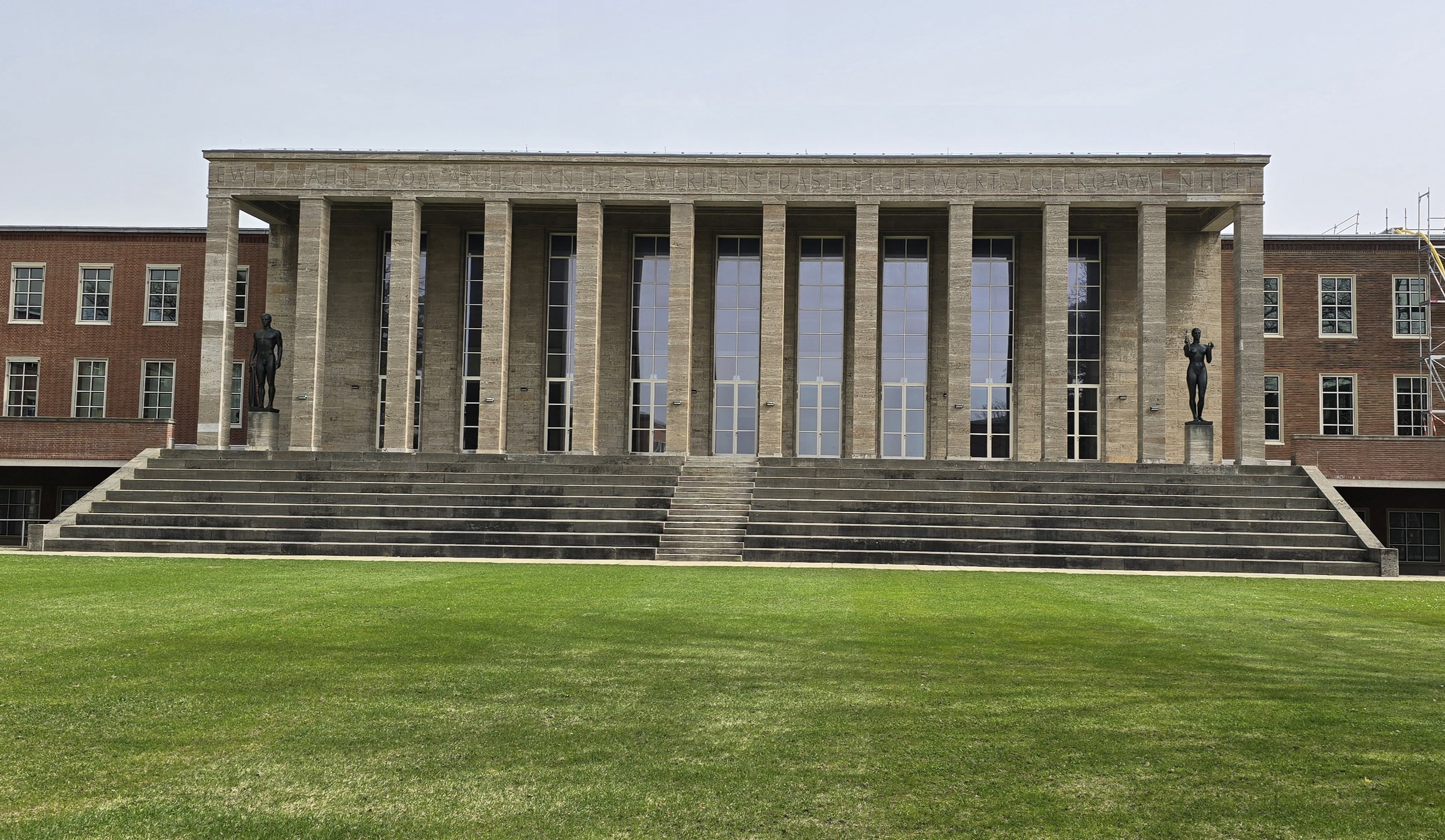Olympic
Stadium
Berlin

The Olympic Stadium
Berlin Olympic Stadium, stadium built for the 1936 Olympic Games in Berlin, part of a sport complex originally called the Reich Sports Field (German: Reichssportfeld), that is now used for international football matches and is the home of Berlin team Hertha BSC.
The Nazis were determined to make the 1936 Berlin Olympics a memorable showcase for Aryan physical superiority, and with this in mind the architect Werner March was commissioned to build the massive stadium (Olympiastadion), the centerpiece of Reich Sports Field in the Grunewald forest to the west of Berlin. In addition to the central Olympic stadium, there was a vast athletics field, the Mayfield (Maifeld), with a capacity of some 75,000; the Waldbühne amphitheater, which held 25,000 spectators; and more than 100 other buildings to accommodate the various Olympic sports.
Work on the Olympic stadium began in 1934 and was completed in time for the Games in the summer of 1936. Taking the symmetrical form of a large oval, it was built in the monumental Neoclassical style favored by the Nazis and was capable of holding 110,000 spectators. The structure was partially dug into the ground so that the field itself was some 40 feet (12 m) below ground level. Its sheer scale was intended to impress the world and inspire awe, and in this it succeeded. Although Germany topped the medals table, the 1936 Games were most memorable for the performances of American athlete Jesse Owens, who won four gold medals in the track-and-field events and, because he was Black, completely undermined the myth of Aryan superiority.
After World War II, the stadium was taken over by the British and became part of their military occupation headquarters, where it was used for general sporting activities as well as acting as the home for the local football team, Hertha BSC Berlin. After the British withdrawal in 1994, the German authorities decided to redevelop the stadium. The new high-tech, multipurpose stadium was opened in 2004.
The Berlin Olympic Stadium was one of the main venues for the 2006 World Cup and hosted the UEFA Champions League final in 2015 and will play host to the 2024 Euros.
Werner March
For the 1936 Summer Olympics in Germany, March created his most famous work, Berlin Olympic Stadium, which was on the site of the Deutsches Stadion, a stadium designed by his father, Otto March for use in the 1916 Summer Olympics (which were later cancelled after the outbreak of World War I). It is unclear whether March was influenced to use a more conservative design to suit Nazi tastes (claimed by Albert Speer), or whether March devised a grand, sweeping architecture that anticipated the spirit of the Third Reich.
The stadium, which has a capacity of 74,228, is one of the Germany's major sports venues and was used both for the 1974 and 2006 FIFA World Cup. He also created plans for the Central Stadium (Leipzig, GDR). He designed Carinhall, Hermann Göring's hunting lodge-style country residence near Berlin. During 1956 to 1960 he designed the Cairo International Stadium in Egypt. Designed as a multi-purpose stadium for the Olympic sports, it is primarily used as a venue for football games.
Together with his brother Walter, Werner March won a gold medal in the Art competitions at the Summer Olympics in 1936.
Jessie Owens
In 1936, Owens and his United States teammates sailed on the SS Manhattan and arrived in Germany to compete at the Summer Olympics in Berlin. According to fellow American sprinter James LuValle, who won the bronze in the 400 meters, Owens arrived at the new Olympic stadium to a throng of fans, many of them young girls yelling "Wo ist Jesse? Wo ist Jesse?" ("Where is Jesse? Where is Jesse?"). Just before the competitions, founder of Adidas athletic shoe company Adi Dassler visited Owens in the Olympic village and persuaded Owens to wear Gebrüder Dassler Schuhfabrik shoes; this was the first sponsorship for a male African American athlete.
Medal record
Men's track and field Representing the United States - 4 Gold medals
Gold 100 m
Gold 200 m
Gold 4×100 m relay
Gold Long jump
Adolf Dassler
Dassler was aware of the danger of an African American contestant wearing German shoes. African Americans were targets of the Führer’s vile ideology, and Adidas would easily become a target of severe repercussions from the German government. Still, Dassler and Waitzer disregarded the possible dangers concerning the promotion of their product. They approached Owens at the Olympic Village and offered him the special shoes that were designed and crafted by Dassler himself.
Owens was amazed by the shoes, which had long hand-forged spikes and were made of resilient leather. He said that he would either wear these shoes or no shoes while competing. He wore the shoes when he won his medals and officially became one of the greatest athletes in history.
Adi” Dassler, founder of the German sportswear company Adidas (Photo Credit: ullstein bild / ullstein bild via Getty Images)
The Adidas cleats Jesse Owens wore in the 1936 Olympics Photo courtesy of "Rise of the Sneaker Culture" exhibit
11th Olympiad. One hundred thousand pack Berlin Stadium.
Jesse Owens wins 4 gold medals in the 1936 Berlin Olympics.
A now & then of the Olympic Stadium, built for the 1936 Olympic Games.
My Photos March 2024














